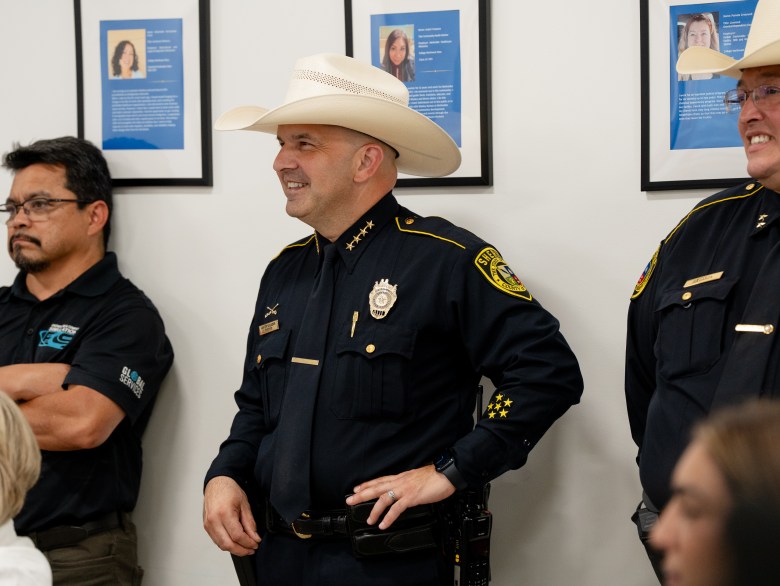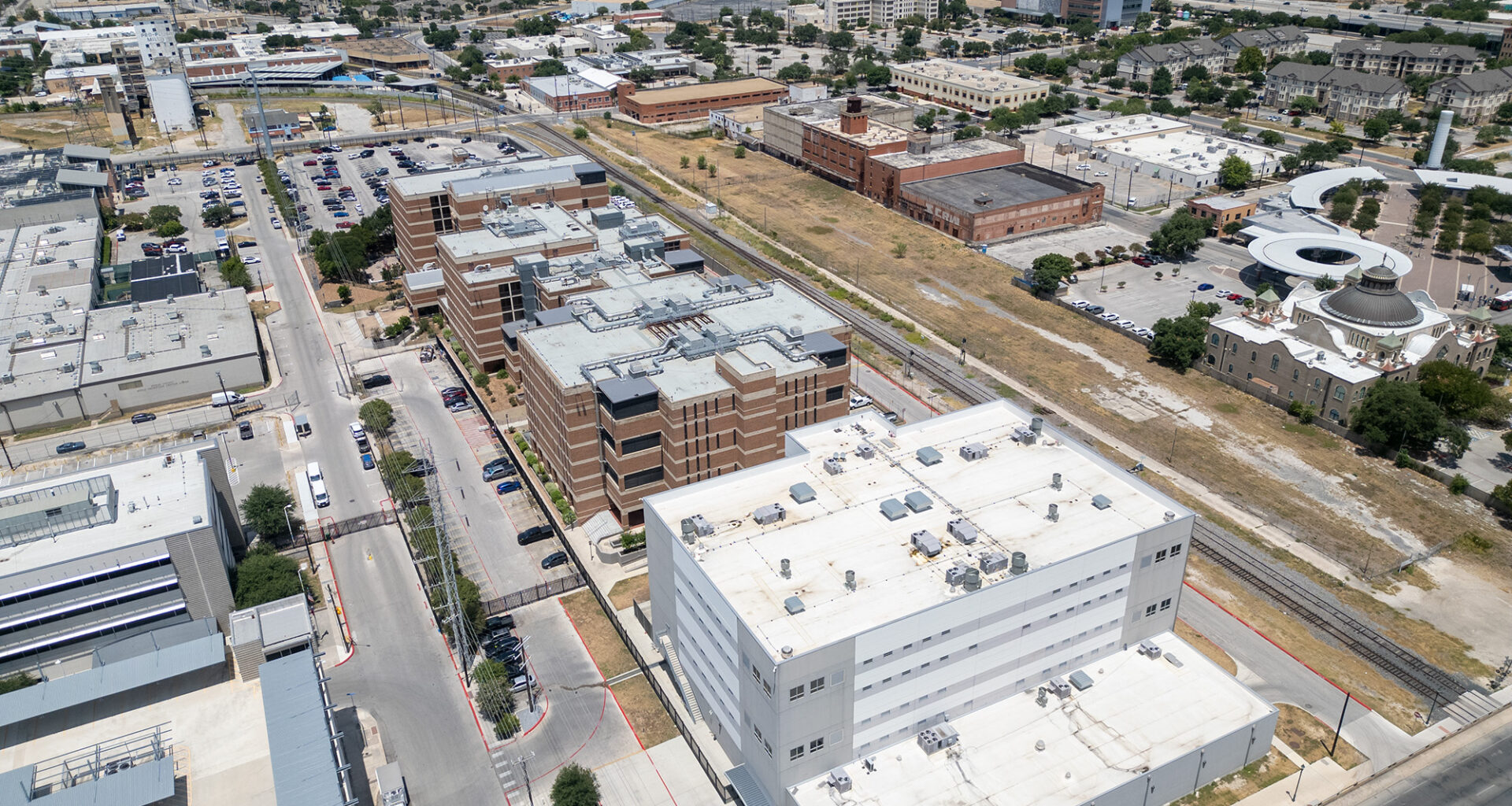Every day, Bexar County Sheriff’s Office deputies oversee a jail population nearing full capacity. But, the jail can’t seem to keep enough jailers on staff to supervise inmates — a shortage that’s contributed to regulatory violations and millions in overtime pay.
Public records show that as of Aug. 11 the Bexar County Jail’s in-custody population reached 4,914. Data from Texas Commission on Jail Standards lists the jail’s capacity as 5,108, placing Aug. 11 numbers at 96.2% capacity.
This strain has coincided with high turnover, two notices of noncompliance from the Texas Commission on Jail Standards within the past year and millions spent on paying the staff it has overtime pay.
In 2023, in an effort aimed at curbing rampant vacancies and reducing turnover, the Bexar County Commissioners Court unanimously approved a sweeping salary adjustment for sheriff’s deputies.The changes cost the county roughly $9.6 million annually while establishing a “straight to the streets” policy allowing cadets to go directly into patrol.
Despite those initiatives, staffing shortfalls persist. As of Aug. 7, the jail had 147 open deputy positions in the detention division, with 40 cadets in training, according to records obtained by the San Antonio Report.
The department has struggled with high turnover in the two years since the pay raises took effect. From August 2023 through May 2025, 478 licensed jailers left the department, according to state data.
While most months saw between 10 and 25 departures, the number spiked to 45 in April, marking the highest monthly turnover since the raise was approved.
The persistent turnover has coincided with operational challenges inside the jail.
In late July, the state commission issued a notice of noncompliance after inspectors found inadequate documentation that inmates in administrative separation — a form of solitary confinement — were receiving the required one hour of dayroom access per day.
To address the issue, BCSO implemented a digitized documentation system and retrained staff. The jail officially regained compliance on Tuesday, Aug. 19, according to an email from BCSO Public Information Officer Deputy Johnny Garcia.
The July notice marked the second time in less than a year that the jail fell out of compliance.
In November 2024, following a custodial death investigation, TCJS inspectors cited two deficiencies: one for holding an inmate in intake for over 48 hours and another for failing to properly document or administer prescribed medications during multiple observation rounds conducted by jailers while the inmate was in holding.
BCSO submitted corrective action plans in response to both violations and regained compliance on Dec. 31.
Staying compliant, however, hinges on meeting all outlined minimum jail standards. When it comes to staffing, state minimums only require at least one jailer on each floor that houses 10 or more inmates and no fewer than one jailer per 48 inmates per floor for direct supervision.
These requirements apply per shift, not across the entire facility. The Bexar County Sheriff’s Office reported 771 deputies assigned to the jail as of Aug. 7, but only a portion of those employees are on duty at a time due to shift rotations.
 Bexar County Sheriff Javier Salazar attends a Town Hall with County Judge Peter Sakai and Precinct 2 Commissioner Justin Rodriguez regarding county budget at the Westside Education and Training Center in Bexar County Precinct 2 in 2024. Credit: Brenda Bazán / San Antonio Report
Bexar County Sheriff Javier Salazar attends a Town Hall with County Judge Peter Sakai and Precinct 2 Commissioner Justin Rodriguez regarding county budget at the Westside Education and Training Center in Bexar County Precinct 2 in 2024. Credit: Brenda Bazán / San Antonio Report
With over a hundred vacancies the sheriff’s office has relied heavily on overtime to maintain coverage, which means paying a detention officer at least $34.47 an hour once they hit 40 hours that week. The hourly pay could be more depending on the officer’s rank.
At an Aug. 12 Commissioners Court meeting covering the proposed budget for fiscal year 2026, Budget Director Tanya Gaitan said the sheriff’s office spent over $20 million on overtime and compensatory time in fiscal year 2025. County officials want to reduce overtime pay by $5 million in the upcoming budget.
The budget also includes funding for 70 new detention positions. But that funding is being held in contingency — a budgetary holding pattern meant to signal that new positions alone won’t fix the jail’s staffing crisis.
“We are asking the sheriff’s office if they can work with us and the Commissioners Court to determine how they’re going to decrease overtime once they fill those positions — and how they’re going to actually fill them,” Gaitan said. “Right now the court is paying time and a half to fill the South Tower, and as you know, the jail population is at its maximum — sometimes more.”
County Manager David Smith told the Report at a subsequent budget town hall that projections suggest the sheriff’s office won’t be able to access the funding in the next year.
“He still has 140 vacant positions elsewhere. It’ll probably take a year for him to begin addressing those several positions,” Smith said, referring to Sheriff Javier Salazar. “We put it in contingency — it’s not in his budget yet — so we can see if he speeds up his hiring process. But if he sticks to the normal trend, we don’t think they’ll get there.”
Advocates, however, say vacancies are only part of the problem.
“Understaffing gets used as a catch-all excuse for everything that goes wrong in jail,” said Krishnaveni Gundu, co-founder and executive director of Texas Jail Project, a nonprofit organization that advocates for and with people incarcerated in Texas county jails and their loved ones.
“But you’re never going to have enough staff when you’re incarcerating at this level.”
She pointed to the high share of Bexar County inmates held pretrial — many on low-level or nonviolent charges — as a key factor draining jail resources. “If you’re holding people on Class B or Class A misdemeanors who can’t afford bail, you’re wasting precious staffing and jail resources,” she said.
As of July 1, state data reported 750 inmates were held pretrial on misdemeanor charges, accounting for roughly 15% of the total jail population.
Without broader reforms to reduce reliance on pretrial incarceration, Gundu said, counties like Bexar will remain trapped in a cycle of costly turnover, repeated noncompliance and avoidable harm.
The proposed County 2026 budget is expected to be finalized in September.
